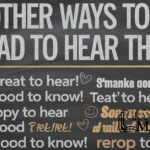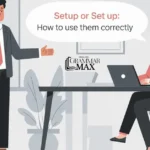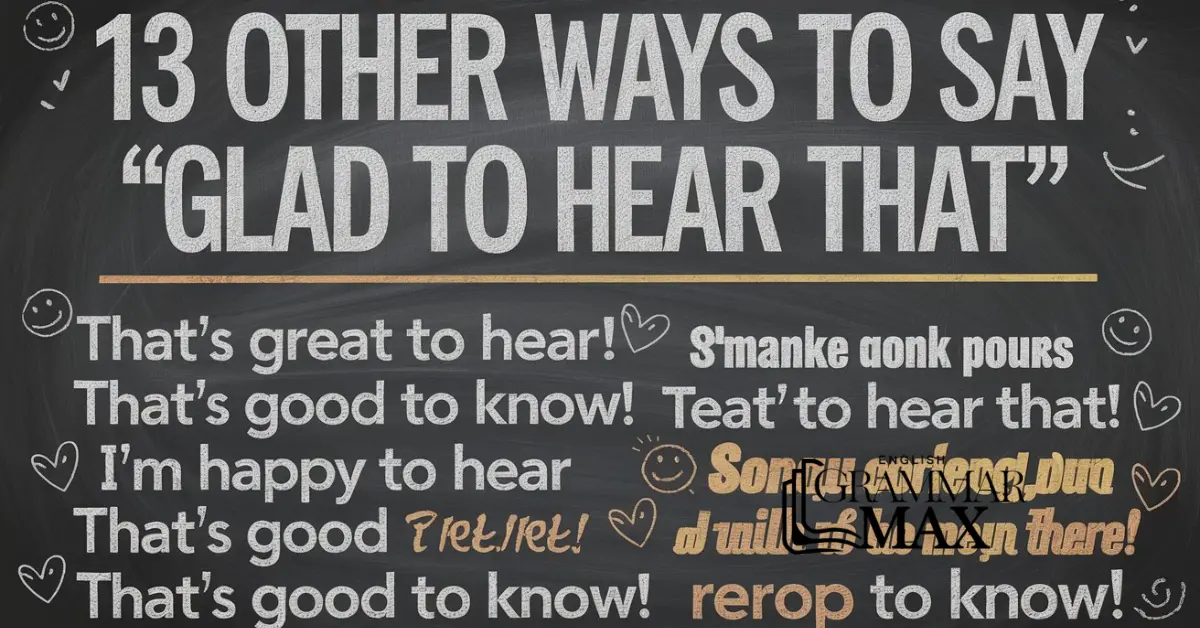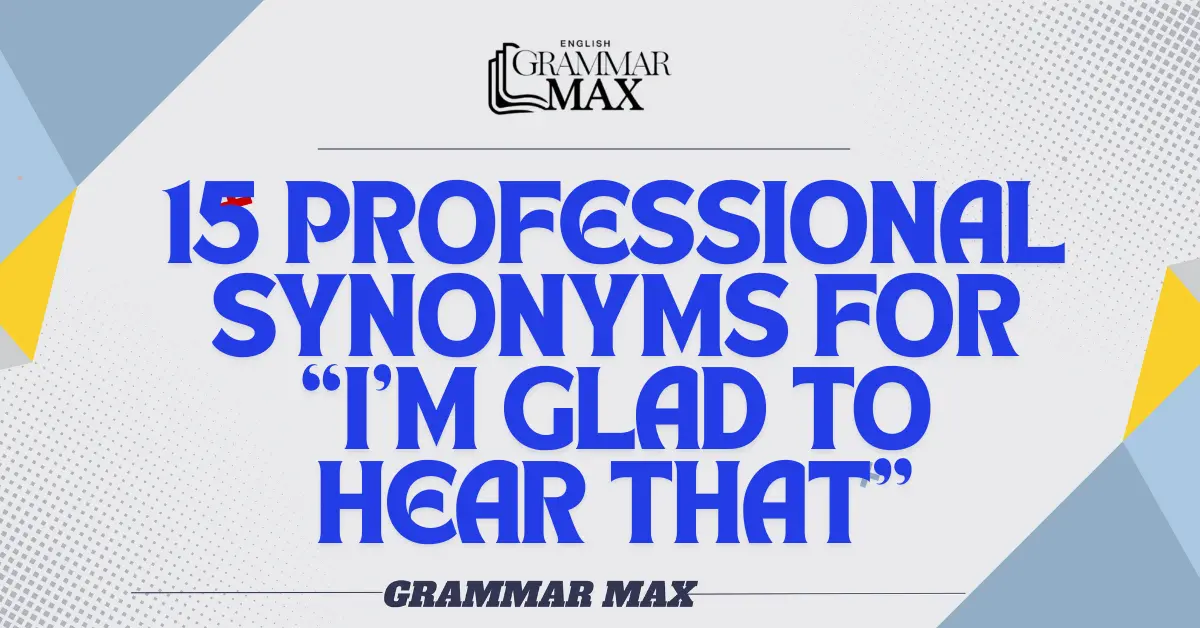“Glad to hear that” is a simple yet effective phrase to express happiness or satisfaction in professional or personal communication. It acknowledges good news while maintaining a polite and friendly tone. Whether you’re responding to a colleague in corporate communication or offering support to a friend, this phrase serves as a versatile option for positive exchanges.
However, overusing “Glad to hear that” can make your conversations sound repetitive or monotonous. To enhance your professional communication and add diversity to your language, it’s essential to explore alternatives. This article offers 13 ways to say “Glad to hear that”, complete with explanations and examples to suit various scenarios.
Alternative Ways to say “Glad to Hear That”
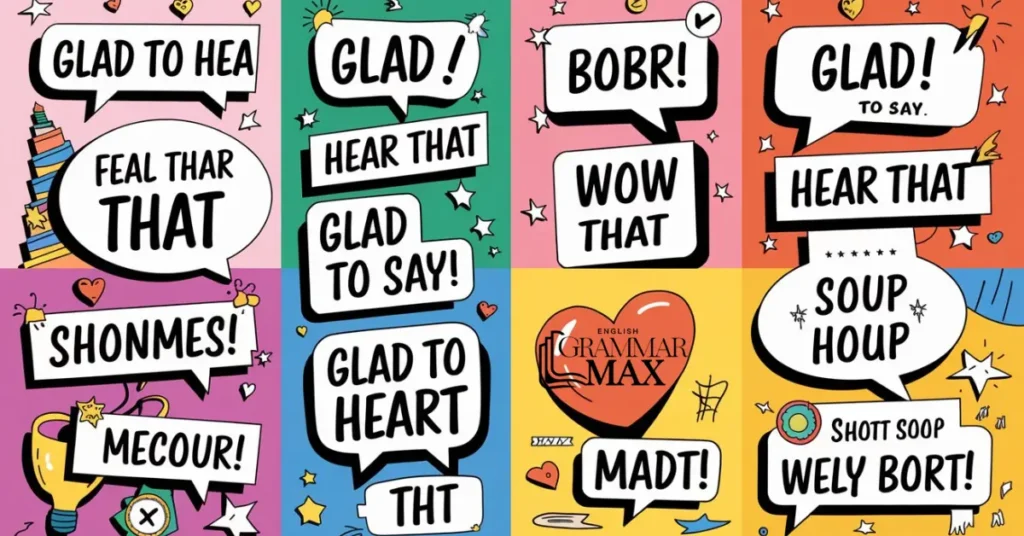
You can use these ways instead to say Glad to hear that:
- Happy to hear
- Thrilled to hear
- Pleased to learn
- Great to hear
- Good news
- Delighted to learn
- Happy to know
- Glad to know
- Wonderful news
- Fantastic news
- Incredible update
- Exciting update
- Positive update
Happy to Hear
“Happy to hear” is a warm and uplifting phrase that conveys genuine positivity. It is versatile and can be used in both formal communication and informal expressions, making it suitable for emails, texts, or casual conversations. This phrase shows that you value the good news being shared with you.
For example, responding with “I’m happy to hear that your presentation went well” adds a touch of encouragement. It’s a great way to provide positive responses while maintaining a polite and friendly tone, perfect for fostering connection in personal and professional relationships.
Best Use:
The phrase “Happy to hear” is best used in professional communication to acknowledge positive updates in a warm and encouraging tone. For instance, it works well in emails like, “I’m happy to hear that the project was completed on time.”
Example:
Subject: Great Progress!
Dear Mark,
I’m truly happy to hear about your team’s successful presentation. Your hard work is paying off, and I look forward to more updates.
Best regards,
Anna
Thrilled to Hear
“Thrilled to hear” adds an extra layer of enthusiasm to your acknowledgment. It conveys excitement and can help emphasize expressing joy in situations like promotions, achievements, or milestones. This phrase is best used in contexts where a heightened level of enthusiasm feels appropriate.
For instance, saying, “I’m thrilled to hear about your success with the project!” adds a sense of celebration and excitement to your communication. It works well in business-friendly phrases to highlight shared joy while maintaining professionalism.
Best Use:
“Thrilled to hear” is ideal for moments when you want to show excitement and expressing joy over achievements or milestones. Use it in celebratory messages such as, “I’m absolutely thrilled to hear about your promotion!”
Example:
Subject: Amazing News!
Hi Sarah,
I’m absolutely thrilled to hear about your promotion! Congratulations on this well-deserved achievement. Let’s celebrate soon.
Cheers,
John
Pleased to Learn
“Pleased to learn” is a polished and formal phrase, ideal for professional communication or corporate correspondence. It expresses appreciation for being informed and shows respect for the person sharing the news.
For example, writing, “I’m pleased to learn about the positive feedback from our client” conveys gratitude and enthusiasm without being overly casual. It’s a perfect fit for polite acknowledgments in emails or workplace discussions.
Best Use:
The phrase “Pleased to learn” fits perfectly in business-friendly phrases, especially when acknowledging formal updates or client successes. For example, “I’m pleased to learn that the client approved our proposal.”
Example:
Subject: Congratulations!
Dear Mr. Lewis,
I am pleased to learn about your recent recognition at the annual conference. Your dedication inspires us all.
Sincerely,
Rachel
Great to Hear
“Great to hear” strikes a balance between professional and casual, making it ideal for various communication settings. It’s a simple and effective way to acknowledge good news without sounding too formal or overly enthusiastic.
You might write, “It’s great to hear that the event was a success,” in a professional email or during a team update. Its versatility allows it to function seamlessly in email-friendly alternatives or verbal exchanges.
Best Use:
“Great to hear” is versatile and works in both formal communication and casual conversations. It’s ideal for quick responses like, “It’s great to hear that the event went smoothly.”
Example:
Subject: Update on the Project
Hi Emily,
It’s great to hear that the project timeline is on track. Let me know if there’s anything I can assist with.
Best,
Mike
Good News
“Good news” is a straightforward and universally understood phrase that conveys optimism and relief. It is perfect for situations where a concise acknowledgment is appropriate, such as quick updates or informal conversations.
For example, “That’s good news about the client’s approval!” works well in team discussions or casual workplace chats. This phrase fits perfectly into positive responses while maintaining a neutral tone.
Best Use:
“Good news” is perfect for concise acknowledgments or sharing positivity in team updates or casual chats. For example, “That’s good news about the contract renewal!”
Example:
Subject: Excellent Milestone
Dear Team,
Thank you for the update. This is good news, and it reflects your dedication and teamwork. Let’s keep the momentum going!
Best regards,
Laura
Delighted to Learn
“Delighted to learn” adds a touch of warmth and formality, making it suitable for business-friendly phrases or personal connections. It conveys heartfelt happiness and appreciation for the shared information.
For instance, you could write, “I’m delighted to learn that the new strategy is yielding results.” This phrase works well in professional communication, showing both encouragement and enthusiasm.
Best Use:
“Delighted to learn” is best suited for professional communication, particularly when addressing senior colleagues or clients. Use it in formal emails such as, “I’m delighted to learn about the progress on this initiative.”
Example:
Subject: Incredible Achievement
Dear Tom,
I’m delighted to learn about your successful pitch to the client. It’s a fantastic milestone for the team.
Warm regards,
Samantha
Happy to Know
“Happy to know” is another versatile option that conveys genuine positivity. It can be used in both professional and personal contexts, making it a great choice for diversifying language in your conversations.
For example, writing, “I’m happy to know that the project is progressing smoothly,” acknowledges progress while maintaining a supportive tone. It’s a perfect phrase for fostering close connection phrases in workplace or personal exchanges.
Best Use:
“Happy to know” works well for maintaining a positive tone in both personal and workplace communication. For example, “I’m happy to know that the team is meeting their targets.”
Example:
Subject: Positive Progress
Hi Daniel,
I’m happy to know that the client is satisfied with our proposal. Let’s ensure the next steps are equally smooth.
Best,
Claire
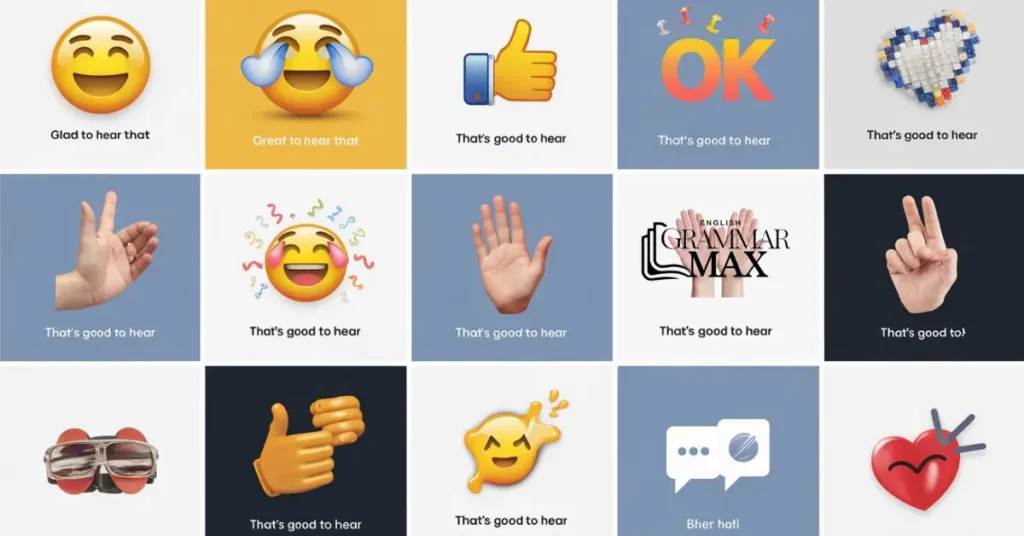
Is it Professional to say “Glad to Hear That”?
It is professional to say “Glad to hear that” as it conveys a positive and courteous response, suitable for various communication contexts. This phrase is versatile and works in both formal communication and casual interactions, making it a reliable choice in emails, meetings, or workplace chats.
For more about language usage and writing styles, you can explore trusted resources such as Merriam-Webster Dictionary.
However, overusing this expression may come across as robotic or insPrivacy Policyincere, and in highly formal settings, it might lack the gravitas needed. To strike the right tone, consider the relationship and context before using it.
Pros
- Polite and friendly tone.
- Fits both formal and informal settings.
Cons
- Can sound repetitive if overused.
- May lack formality in high-level communication.
Frequently Asked Questions
What Does Glad to Hear That Mean?
“Glad to hear that” means you are pleased or happy about the information or news someone has shared with you. It reflects positivity and acknowledgment.
What Is Another Way to Say Glad to Hear That?
You can say “happy to hear,” “thrilled to hear,” or “pleased to learn” as alternatives to “glad to hear that.”
Learn more about the science behind ignition from ScienceDirect.
What Can I Say Instead of “Good to Hear”?
Consider using phrases like “great to hear,” “wonderful news,” or “fantastic news” as substitutes for “good to hear.”
How to Reply Glad to Hear That?
Respond by expressing gratitude or sharing additional positive remarks, such as “Thank you, I appreciate that” or “I’m glad you think so too.”
Conclusion
“Glad to hear that” is a widely used phrase for acknowledging good news, but exploring alternatives can enrich your conversations. By diversifying your language, you can tailor your responses to suit various professional and personal contexts.
From business-friendly phrases like “Pleased to learn” to informal expressions such as “Happy to hear,” these alternatives offer flexibility and variety. Incorporating them in professional communication ensures your tone remains engaging and effective. Whether in emails, messages, or meetings, these phrases enable you to deliver polite acknowledgments while maintaining an empathetic and positive tone.

William Henry is a writer for Grammar Max, a blog that focuses on synonyms and phrases. He loves exploring the quirks of the English language and enjoys helping readers improve their vocabulary. William’s articles are easy to read, fun, and full of useful tips for anyone looking to better understand and use English. Whether you’re a student, a professional, or just someone interested in language, William’s writing on Grammar Max makes learning about words and their meanings simple and enjoyable.







